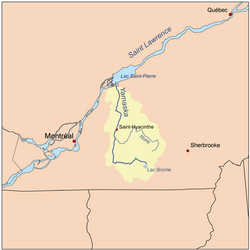| Yamaska River | |
|---|---|
 The Yamaska River near Saint-Hyacinthe | |
 | |
| Native name | Rivière Yamaska (French) |
| Location | |
| Country | Canada |
| Province | Quebec |
| Region | Montérégie, Centre-du-Québec |
| City | Saint-Hyacinthe |
| Physical characteristics | |
| Source | Brome Lake |
| • location | Brome Lake, Montérégie, Quebec, Canada |
| • coordinates | 45°15′N 72°31′W / 45.250°N 72.517°W |
| • elevation | 194 m (636 ft) |
| Mouth | Lac Saint-Pierre (Saint Lawrence River) |
• location | Saint-François-du-Lac, Centre-du-Québec, Quebec, Canada |
• coordinates | 46°06′50″N 72°56′13″W / 46.11389°N 72.93694°W |
| Length | 160 km (99 mi) |
| Basin size | 4,784 km2 (1,847 sq mi) |
| Discharge | |
| • location | Lac Saint-Pierre |
| • average | 83 m3/s (2,900 cu ft/s) |
The Yamaska River (French: rivière Yamaska) is a river in southern Quebec, Canada.
Sourcing water within the Eastern Townships, it ends its journey in Lake Saint-Pierre where it is a tributary to the Saint Lawrence River; altogether it is 177 km (110 mi) long. Crossing nearly twenty municipalities in its course, it is intrinsically linked to life around it as it is a primary source of fresh water where it passes; due to human use and adaptation, the river and its banks have become heavily altered over time, beginning around the time the first European settlers arrived to modern days.
Before exploitation, the river was rich with life. Urban, industrial, and intensive agricultural use have made it one of the most polluted rivers in Quebec, especially from agricultural waste and pesticides; nevertheless, many municipalities use it as their source for drinking water.[1] Although the number of species of living organisms has greatly decreased, a tenacious ecosystem still thrives along many parts of the Yamaska, some efforts are made by the citizens of various municipalities to alter human impact on the environments that connect to the stream.[2] The Yamaska is used for recreational activities such as fishing and many navigate its waters, though it is not used for swimming.
For many years the pollution issue has spawned environmental concern in places such as Granby, where citizens, environmental experts, municipal councilors, as well as groups and organizations work on conservation, study, inventory, and communication of ways to change an individual's impact on the river's health. These actions have led to the increase of community art and events aiming to speak for those who cannot, mainly animals and plants.[3]
- ^ Développement durable, de l'Environnement et des Parcs Québec, Bassin versant de la rivière Yamaska – Modifier nos pratiques agricoles... la priorité, 1997 (Online version)
- ^ Hébert, Claude (15 April 2015). "Lac Boivin: 120 citoyens prennent connaissance du plan d'action". Retrieved 1 December 2015 – via Granby Express.
- ^ "PROJET: ART YAMASKA". 2013. Retrieved 1 December 2015 – via Atelier 19 – Art & créativité.